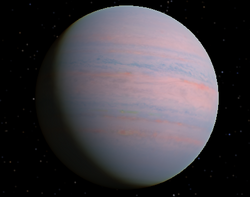Astronomy:Gliese 176 b
| Discovery | |
|---|---|
| Discovered by | Endl,[1] Forveille et al.[2] |
| Discovery date | September 7, 2007 |
| radial velocity | |
| Orbital characteristics | |
| 0.066±0.001 AU | |
| Eccentricity | 0.148+0.249 −0.036 |
| Orbital period | 8.776+0.001 −0.002 d |
| astron|astron|helion}} | 2450839.760 |
| 150.6+42.2 −104.5 | |
| Semi-amplitude | 4.49+1.00 −0.23 |
| Star | Gliese 176 |
| Physical characteristics | |
| Physics | ~450[2] |
Gliese 176 b is a super-Earth exoplanet approximately 31 light years away in the constellation of Taurus. This planet orbits very close to its parent red dwarf star Gliese 176 (also called "HD 285968").
The initial announcement confused the planetary periodicity with the stellar periodicity of 40 days, thus giving a 10.24 day period for a 25 Earth-mass planet.[1] Subsequent readings filtered out the star's rotation, giving a more accurate reading of the planet's orbit and minimum mass.
The planet orbits inside the inner magnetosphere of its star. The quoted temperature of 450 K is a "thermal equilibrium" temperature.[2]
It is projected to be dominated by a rocky core, but the true mass is unknown. If the orbit is oriented such that we are viewing it at a nearly face-on angle, the planet may be significantly more massive than the lower limit. If so, it may have attracted a gas envelope like Uranus or Gliese 436 b.[2]
References
- ↑ 1.0 1.1 Endl, Michael et al. (2008). "An m sin i = 24 M⊕ Planetary Companion to the Nearby M Dwarf GJ 176". The Astrophysical Journal 673 (2): 1165–1168. doi:10.1086/524703. Bibcode: 2008ApJ...673.1165E.
- ↑ 2.0 2.1 2.2 2.3 Forveille, Thierry; Bonfils, Xavier; Delfosse, Xavier; Gillon, Michaël; Udry, Stéphane; Bouchy, François; Lovis, Christophe; Mayor, Michel et al. (2009). "The HARPS search for southern extra-solar planets. XIV. Gl 176b, a super-Earth rather than a Neptune, and at a different period". Astronomy and Astrophysics 493 (2): 645–650. doi:10.1051/0004-6361:200810557. Bibcode: 2009A&A...493..645F. https://www.aanda.org/articles/aa/full/2009/02/aa10557-08/aa10557-08.html.
External links
- "Notes for planet HD 285968 b". Extrasolar Planets Encyclopaedia. http://exoplanet.eu/planet.php?p1=HD+285968&p2=b.
- "HD 285968". Exoplanets. http://media4.obspm.fr/exoplanets/base/etoile.php?nom=HD+285968.
Coordinates: ![]() 04h 42m 55.7768s, +18° 57′ 29.417″
04h 42m 55.7768s, +18° 57′ 29.417″
 |


